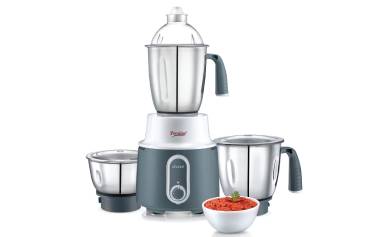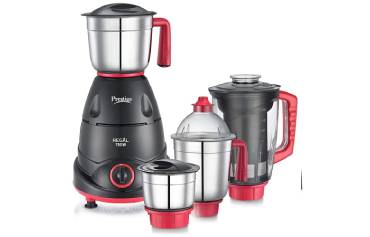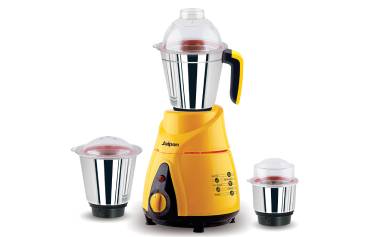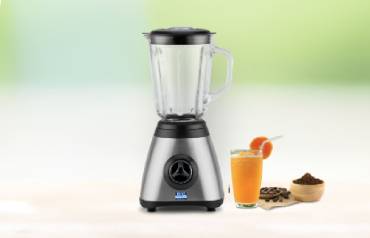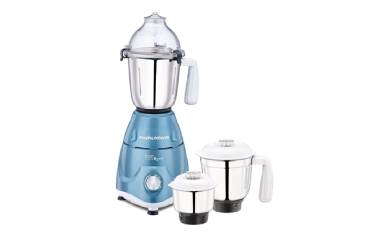I set out to find the best mixer grinders under ₹3000 that don’t cut corners on power or safety. I focused on 500–750W motors, overload protection, thermal cut-off, and at least three stainless-steel jars. I also checked build, blade quality, noise, and real-world grinding speed for spices, chutneys, and batter. If you want reliable performance without overspending, my top picks and comparisons will show exactly what’s worth your money next.
Key Takeaways
- Choose 500–750W copper motors with overload protection, 3 speeds plus pulse, and ISI/BIS compliance for reliable performance under ₹3000.
- Prefer sets with three stainless-steel jars: 0.4L chutney, 1L multipurpose, and 1.5L wet jar with leak-proof gaskets.
- Look for safety essentials: shock-proof ABS body, anti-skid feet, locking lids, and thermal cut-off protection.
- Best value typically comes from 750W, 3-jar models with 304-grade blades and durable jar thickness for sustained RPM under load.
- Check warranty: minimum 2-year product and motor coverage with accessible service centers; maintain with proper cleaning and timely gasket/coupler replacements.
How We Picked and Tested
Although price was the boundary, performance drove every decision. I shortlisted current sub-₹3000 models from major brands, verified BIS compliance, and confirmed warranty length and service coverage. I filtered for copper motors, overload protection, and stable ABS bodies with anti-skid feet. I recorded jar materials (stainless vs. polycarbonate), lid locks, blade grade, and coupler type.
I tested each unit with standardized loads: 50 g dry spices, 200 g soaked dals, 500 g chutney, and ice with milk for stress. I timed grind cycles to reach a consistent particle size, checked heat rise after 5 minutes, and measured noise at 1 meter. I inspected cord quality and plug rating, evaluated vibration on wet countertops, and validated thermal cut-off response. I weighted results for durability, safety, and value. Additionally, I noted overload protection and safety locks as essential safety features that prevent motor damage and ensure secure operation.
Key Features to Prioritize Under ₹3000
With the tests in place, I focused on the specs that actually move the needle under ₹3000. You’ll get reliable grinding if you prioritize motor strength, jar quality, build safety, and warranty. I’m weighing performance against durability and safe operation, not flashy extras.
1) Motor: Look for 500–750W, copper winding, overload protection, and a 3-speed + pulse switch. Stable RPM under load matters more than peak wattage.
2) Jars and blades: At least three stainless-steel jars (0.4L chutney, 1L multipurpose, 1.5L wet). Flow breakers, 304-grade blades, and leak-resistant gaskets enhance safety and consistency.
3) Build and safety: Shock-proof body, anti-skid feet, locking lids, and a thermal cut-off.
4) Service and warranty: Minimum 2-year product + motor coverage, accessible service centers, and easily available jar couplers and gaskets.
For budget picks under ₹3000, prioritize models that include an overload protector, anti-skid feet, and 304-grade blades as highlighted in the key attributes.
Top 5 Mixer Grinder Picks and Who They’re For
Once I filtered out the hype and stuck to the specs that matter under ₹3000, five models stood out for clean grinding performance, durable jars, and real-world safety.
1) Daily Grinds: 500W copper motor, 2 stainless-steel jars (0.8L/1.2L), overload cut-off, non-slip feet. For basic chutneys and dry masalas with minimal heat.
2) Wet-Heavy Home: 750W, flow-breaker wet jar (1.5L), ventilated base, lid locks. For idli/dosa batter without motor strain.
3) Spice Pro: 600W, hardened SS blades, pulse + 3 speeds, safety coupler. For fine turmeric/garam masala grinds.
4) Small Kitchen: 500W, compact body, 2 leak-resistant jars, shock-proof ABS. For tight counters and quick blends.
5) Family All-Rounder: 750W, 3 jars (0.4L/1L/1.5L), thermal fuse, anti-surge cord. For multitaskers needing reliable, safe throughput.
Among 500W options, look for 18,000–23,000 RPM blade speed and stainless-steel jars with at least a 1–2 year warranty for effective, everyday grinding.
Side-by-Side Comparison and Value Analysis
You’ve seen who each pick suits; now I’ll stack them by motor output, jar set, safety, and real-world grind quality to clarify what you’re paying for. Under ₹3000, 500–750W motors dominate. I rate value on sustained RPM under load, stainless jar thickness, lid lock design, and overload cut-off reliability. A 750W unit with 3 jars (0.4L chutney, 1L multi, 1.5L wet) usually offers the best rupee-per-task ratio, provided it includes non-slip feet and food-grade, BPA-free lids.
1) Motor: Prefer copper-wound, 750W, with thermal overload protector and 3-speed plus pulse.
2) Jars: Minimum 3 stainless jars; leak-proof gaskets; ergonomically shrouded handles.
3) Blades: 304 SS multipurpose + wet grinding curvature for idli batter.
4) Safety: Lid interlock or at least click-fit lids, anti-skid feet, shock-proof body, ISI certification.
I’d prioritize proven service network second. Also consider under-₹2000 models with 500W motors, tri-speed control, and overload protection, like the Bajaj Rex, which pair stainless jars and anti-skid bases for strong budget performance.
Care, Maintenance, and Warranty Tips
Although these grinders are built for daily duty, consistent care protects performance and your warranty. I unplug before cleaning, wipe the motor base with a damp cloth, and keep vents dust-free for cooling. I wash jars immediately, dry thoroughly to prevent bearing rust, and store lids loosely to preserve seals. I avoid overfilling past max marks and use pulse for dry masala to reduce heat and blade wear.
I replace jar gaskets when they flatten, and I check couplers monthly—if teeth round off, I swap them early to save the motor. I never run empty or more than 30–60 seconds continuously; I let it rest to protect windings. I use a surge protector. I keep invoices, register online, and use only authorized service to retain warranty. Also verify that jars have secure jar clasps and use low speeds for blending and juicing to match the typical 450W light-duty design.
Frequently Asked Questions
Can Mixer Grinders Be Used Safely With Inverters or Generators?
Yes, if specs align. I confirm inverter/generator output: pure sine wave, 220–240V, sufficient wattage (2–3× motor rating), stable frequency. I use a surge protector, dedicated socket, proper grounding, and avoid simultaneous heavy loads to prevent overheating.
Are There Low-Noise Mixer Grinders Suitable for Early-Morning Use?
Yes. I recommend models under 80 dB with brushless DC motors, sturdy lids, anti-vibration feet, and balanced jars. I’d choose 500–750W, overload protection, soft-start, and pulse modes. Follow manufacturer duty-cycles and secure placement for safe, quiet mornings.
Which Jars Are Best for Making Nut Butters at Home?
Wide, heavy-duty stainless-steel jars with blunt, flat blades are best. I’d pick 1–1.5L, thick walls, locking lids, tamper support, and ≥750W motor compatibility. They handle viscous loads safely, prevent overheating, and clean easily without harboring residues.
How to Reduce Spice Cloud and Odors While Dry Grinding?
Use a tight-sealing small jar, pulse in 2–3 second bursts, and wait 5–10 seconds between. I add a teaspoon of rice as an anti-caking buffer, grind under an active range hood, and open outdoors wearing a mask.
Are Spare Jars and Blades Interchangeable Across Brands?
No, they’re rarely interchangeable. I’d check thread type, jar base diameter, coupler design, blade hub height, and locking tabs. Mixing brands risks leaks, wobble, motor strain, and injury. Use OEM parts or brand-certified cross-compatible accessories only.
